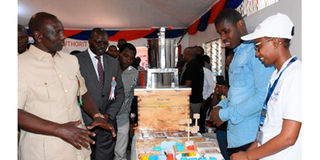MSMEs sector outlook: Context, policy and perspectives for growth
Sponsored by Micro and Small Enterprises Authority

President Dr William Ruto interacts with MSEs at the MSEA pavilion during the 2023 Nairobi International Trade Fair.
Micro, small, and medium enterprises (MSMEs) occupy a very strategic position in the development of Kenya. They cut across all sectors of the economy and have been identified as major contributors to employment creation, income generation and inclusive growth.
The MSME sector directly contributes to 24 percent of national GDP, constitutes 90 percent of private enterprises, and accounts for over 85 percent (14.4 million) of jobs, often held by the disadvantaged segments of the population such as women, youth, and persons with disabilities.
However, despite the sector being a major player in the country’s economy, its full potential is yet to be realised, owing to myriad challenges that continue to plague its growth and development.
The micro and small enterprises (MSEs) policy 2020 describes them as financially excluded, lacking requisite entrepreneurial skills, highly informal, having limited access to markets and market linkages as well as to decent work spaces, highly vulnerable to disaster risks and other shocks, and highly uncoordinated.
MSMEs opportunities for tomorrow
The challenges affecting the Kenyan MSEs have also presented several opportunities. For instance, the devolution of the governance structure prioritises flagship projects that are beneficial to the development of MSEs. Other existing initiatives that benefit MSEs include Access to Government Procurement Opportunities (AGPO) and affirmative action funds targeting youth, women, and persons with disabilities.
The Government, through the Micro and Small Enterprise Authority (MSEA), continually offers MSEs platforms for trade fairs to increase their access to markets. Further, the sector has opportunities under the existing regional trading blocs and trade agreements for expanded markets (e.g. EAC, COMESA, AfCFTA, and AGOA).
The country enjoys political goodwill from leaders who have fully supported the sector. Other opportunities lie in product value addition, research and development, innovation, skills, and technological transfer.
Adaptability is key in ensuring Kenya’s small enterprises become globally competitive. Embracing e-commerce and mobile financial transactions is crucial for business growth. The future of these businesses lies in investing in digital transformation, risk management, business succession planning, and embracing digital technology to improve business efficiency for market access.
The role of MSEA in building a competitive, resilient, adaptive and vibrant MSMEs sector in Kenya
MSEA was established by the MSE Act of 2012 to promote, develop and regulate micro and small enterprises to become key industries tomorrow.
The Authority supports MSEs with the aid of Government, development partners, and other stakeholders. It is implementing various initiatives. They include building infrastructure for common user facilities for MSEs in different constituencies, provision of grants under the Kenya Youth Employment Opportunities Project (KYEOP), capacity building, and assisting MSEs to access markets.
To deliver on its mandate, MSEA has continued to collaborate with various development partners by creating synergies and bridging financial resource gaps. It is implementing its 2020-2024 Strategic Plan, which is anchored on four pillars, namely the development of MSEs, promotion of MSEs, regulation of the MSE sector and strengthening of institutional capacity. With support from the Government, the Authority serves MSEs through the following activities:
1. Provision of decent, accessible and affordable MSEs infrastructure
Constituency Industrial Development Centres
The Constituency Industrial Development Centres (CIDCs) concept aims to construct and equip one CIDC in each constituency, to expand economic opportunities in rural areas for employment creation and regional development. The project targets to facilitate youth participation as artisans and entrepreneurs in value added activities.
The Authority has refurbished and operationalised 200 CIDCs and MSEs worksites. The key activities undertaken include construction and refurbishment of CIDCs; installation of a three-phase connection to CIDCs through a matching fund partnership with the Rural Electrification and Renewable Energy Corporation (REREC); distribution and installation of common user machines to CIDCs; and review and development of MSE infrastructure regulations.
2. Cold storage facilities in Nyandarua, Meru and Kisii counties
The Authority has constructed three cold storage facilities. They are in Nyandarua, Meru, and Kisii counties. The facilities are meant to assist over 5,000 farmers in potato and banana value chains in the regions by giving them a common user space for postharvest loss management, and facilitating agro-processing. The facilities are the first of a kind, with the long-term storage designed to employ a temperature regulation system based on mechanical ventilation to keep produce safe from weather variables, pests, and rodents.
The main works for the three facilities have been completed, and the equipping of the ones in Kisii and Meru is ongoing. The facility in Nyandarua was commissioned by H.E the President on January 25, 2024. However, there is a need for additional funding for effective operationalization.

President Dr William Ruto (centre), Deputy President Rigathi Gachagua (fourth from right), Prime Cabinet Secretary Hon Musalia Mudavadi (second from left), and other dignitaries, during the commissioning of the cold storage facility in Ol Kalou, Nyandarua County. Looking on is the Nyandarua Governor Moses Kiarie Badilisha (second from right).
3. Formalisation of the MSE sector
The Authority operationalised the Office of the Registrar as established under Section 6 of the MSE Act 2012. The Registrar is mandated to facilitate formalisation of MSEs sector through registration of the enterprises, their associations, sub-umbrella entities, and umbrella organisations.
Towards this, MSEA, in partnership with UNDP, developed MSEs registration management system to enable MSEs register online. This effort will create a comprehensive, dependable, accessible, and real time database to provide reliable and timely information on MSEs to facilitate proper planning and policy interventions for the sector. The Authority has been carrying out various sensitisation and registration forums to register individual and association MSEs in all the counties.
4. Facilitation of MSEs to access local, regional and international markets
The Authority has been facilitating MSEs to access local, regional, and international markets to expose their products. This is done through various events and exhibitions organised quarterly across the counties. The Authority also organises an annual EAC trade fair every December. The event rotates in the seven EAC countries, offering MSMEs the opportunity to network, exhibit, and sell products in different countries across the region.
5. Capacity building
Capacity building and training offer MSEs opportunities to enhance their skills through upgrading and reskilling. MSEA trains MSEs on various aspects, including the use of various machines installed in the CIDCs, entrepreneurship, and business development, among others. In the last one year, hundreds of MSEs have been trained on the use of lathe machines installed at the various CIDCs; as well as on entrepreneurship, and digital literacy skills.
6. Kenya Youth Employment and Opportunities Project
Kenya Youth Employment and Opportunities Project (KYEOP) was an ongoing five-year World Bank-funded project whose implementation started in the 2016/2017 financial year.
MSEA has actively been involved in the implementation of KYEOP Component 2 on support for job creation. This component addresses key constraints and market failures that limit the demand for youth employment and their productivity once in employment. It has two sub-components, which include the support for self-employed through the provision of business start-up grants and business development services, and catalytic interventions for job creation and implementation of business plan competition – MbeleNaBiz Business Plan Competition.
The project has impacted the lives of many youths across the 17 counties. A total of 77,821 youths have been offered Ksh40,000 each as start-up grants. Over 9,601 youths have gained from business development services (BDS), while 741 youth have benefitted from a business plan competition that targeted 750 youths and saw 250 of them receiving Ksh3.6 million and 491 getting Ksh900,000 for businesses.
7. The proposed NYOTA project
The National Youth Opportunities Towards Advancement (NYOTA) project will be a scale-up initiative of KYEOP. It will therefore build on lessons learnt in the implementation of the KYEOP project.
The objective of the proposed project is to increase employment and opportunities for earnings and savings for targeted youths in the 47 counties. The project will have four components, which include improving youth employability, support to youth entrepreneurship, supporting savings for Kenyan youth in the informal sector, and strengthening systems and capacity to sustain youth employment and savings initiatives.
8. Kenya Jobs and Economic Transformation (KJET) project
Currently, the Kenya Jobs and Economic Transformation (KJET) project is under the design and identification phase. The Authority is the proposed implementer of Component 2 of the project on MSME Clustering and Aggregation, leveraging on the CIDC model. This component will strengthen the capacity and market access of MSMEs by increasing linkages with downstream buyers and off-takers, targeted provision of shared infrastructure to leverage economies of scale, and targeted technical assistance of MSMEs (or MSME groups/associations).
9. Small Business Development Centres (SBDC)
MSEA has been keen to borrow best practices from the United States Small Business Administration (US-SBA). MSEA’s Strategic Plan (2020–2024) highlighted SBA as one of the potential strategic partners, besides borrowing from its strategic and operational framework. Notably, SBA has SBDC (Small Business Development Centres) as one of their functionalities that has touched the lives of most MSMEs in the United States.
The Model of US-SBDCs has been replicated in Kenya through Strathmore University in seven counties, namely Isiolo, Makueni, Kisumu, Kiambu, Nairobi, Nakuru, and Mombasa.
The model aims at improving the robustness of MSMEs through business guide and capacity enhancement, and providing access to affordable finance and government contracting opportunities. This shall further be an opportunity to enhance capacity for value addition in CIDCs through upscaling (to the other counties) of the Kenya Small Business Development Centres (Kenya-SBDC) model that is currently being implemented in the seven counties.
MSEA is at the advanced stages in discussions with Strathmore University on developing, promoting, and regulating MSEs in Kenya using the SBDC model.
MSE challenges
The MSE sector is large and fast-growing as a result of a shift from blue-collar jobs. To effectively revamp the sector as envisioned by the Government under the MSMEs economic transformation agenda, the MSEs sector requires the requisite resources – both financial and technical – to match the growing needs of the sector. Other challenges include capacity building on various subjects and market access for their products in local, regional and international markets.


